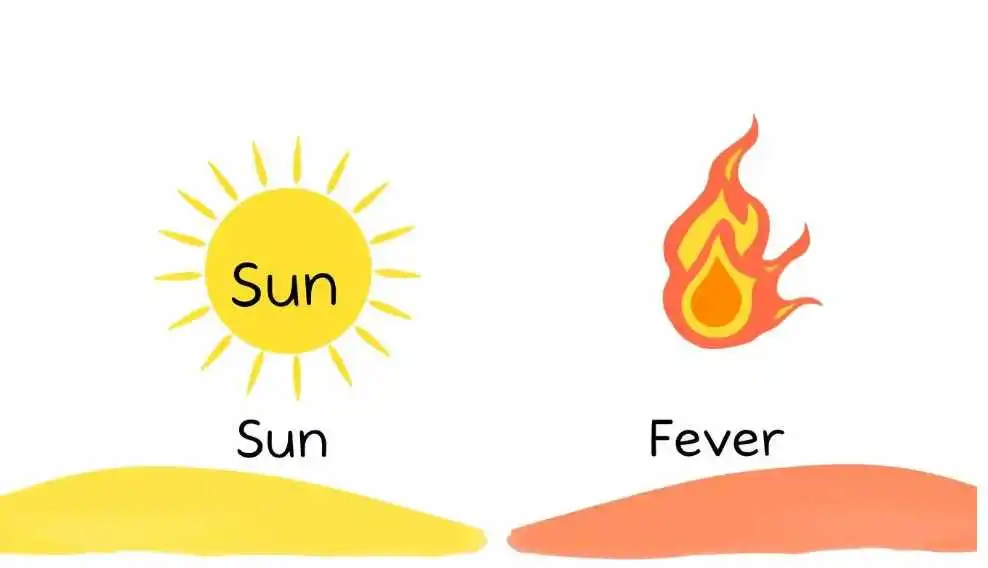Sun vs Fever: Learn the distinctions, between heat resulting from sun exposure and fever. Know the signs of abuse, understand the danger signals and find ways on how to protect themselves and be safe.
You probably did not know this, but over 80 per cent of Americans get sick from the sun vs fever each year. Though these two conditions may sound or look like they are the same, they are different in their causes, symptoms, and impact on a person’s health. One needs to understand the difference to ensure that he or she leads a healthy lifestyle.
Key Takeaways
- Sunburn is totally different from fever in that it is a result of one condition while the other is due to another condition.
- It is therefore important that one identifies the symptoms of sun-induced heat exhaustion and sunstroke to get treatment as early as possible in a bid to reduce complications.
- Fever is the indication of infection, which is the body’s inflammatory response, whilst heat illnesses are the consequences of solar radiation and other conditions.
- Preventive measures could be taken when dealing with the sun by ensuring you take enough water and wear appropriate clothing and sunscreen and in the case of fever, early treatment can also reduce harm resulting from these two aspects of the sun.
The difference between the need for medical care for sun-related ills and fever is important to understand in order to keep oneself in the best of health.
Distinguishing Sun Exposure and Fever.

Using sunlight and the flu as examples one can state that fever and sun produce an effect of rising temperatures in the human body. However, they occur for different causes and they impact on you in various ways. These are some of the differences that one has to understand in order to get the right treatment.
Causes and Mechanisms
Exercise involves sun exposure and which makes the body to struggle in the effects of heat. UV radiation itself if received in excess can cause sunburning and dehydration as well as heat strokes. The other one is fever which is a natural mechanism developed in our body to combat with infection or illness. This occurs when some compounds referred to as pyrogens are produced in your body leading to an increase in the body thermostat.
Physiological Responses
When you are under the sun, your body aims at stabilizing the body temperature hence causing increased blood flow to the skin, production of sweat as well as expansion of blood vessels.
In fever illness control of the body temperature is deactivated. This results into shivering, muscle contraction, and constriction of blood vessels to trap heat, and in the process raise your body temperature.
Sun vs Fever
Sunstroke and common flu may lead to the expression of symptoms such as fatigue, headaches and discomfort resulting from fever. However, they also differ in a myriad of ways as this paper shall seek to establish. One should therefore understand these differences with a view of getting the right treatment to avoid severe complications.
Heat exhaustion and dehydration are some of the effects which are associated with an activity popularly known as sun exposure, which is getting too much sun. While fever is mostly associated with infection or an illness. It helps warm you up, or increases the body temperature.
Characteristic Sun Exposure Fever

- Cause Solar radiation exposure more than needed Unevaluated sickness or condition
- Body Temperature A little raised due to heat, however not over 98. 6 ̊F with the rest above thirty-seven degrees Celsius and the elevated figure above ninety-eight. 6°F (37°C)
- Sweating Sweating is a process of cooling down the body Sweating might be present or can be absent
- Signs of toxicophonia • Fatigue • Headache • Nausea and vomiting • Dizziness • Skin redness Signs to look for when diagnosing toxicophonia • Fatigue • Headache • Body ache • Chills
The content is presented in a table format:
| Characteristic | Sun Exposure | Fever |
| Cause | Excessive exposure to solar radiation | Underlying infection or illness |
| Body Temperature | Elevated due to heat, but not necessarily above 98.6°F (37°C) | Elevated above 98.6°F (37°C) |
| Sweating | Excessive sweating to regulate body temperature | Sweating may be present or absent, depending on the underlying cause |
| Symptoms | Fatigue, headaches, nausea, dizziness, and skin redness | Fatigue, headaches, body aches, and chills |
He pointed out that the effects of sun vs fever has similarities in that they make a person feel bad. But to be able to address it correctly, one has to know what is causing it. A person should consult a doctor if symptoms do not clear or if the situation worsens. This apart, it can help avert other complications.
Symptoms and Warning Signs
It is very important to know what may happen to you when you are exposed to the sun or you have fever. Radiation produces skin inflammation, oedema and stinging. There is sunstroke that can cause various problems including dizziness, nausea and even confusion. Fever causes elevated temperature of the body, shivering and fatigue.

However, watch how long and how severe these symptoms are. Any exposure to sun vs fever, if beyond such a duration, would require that you seek the services of a doctor. This is to make sure one does not faint due to heat stroke or because of lack of water. It is good to seek medical assistance early because; it helps the body to heal quickly, and it minimizes the risks associated with illnesses.
The knowledge about the battle against sun exposure and fever assists people in taking care. Therefore, by avoiding the sun, drinking water, and checking the temperature one can remain healthy. These steps are useful in avoiding such concerns from occurring They are as follows.
FAQ-Sun vs Fever
What can you infer regarding the differences of sun exposure and fever?
This can be the reason why we cannot take a bath during the evening when the heat of the sun is felt most or during times of fever when the body’s temperature is high. Heat also causes your body temperature to rise as a result of heat from the sun and when the body is dehydrated. Sickness occurs when the body develops some diseases or you start having an infection.
How does the body’s temperature regulation process differ in sun exposure versus fever?
A fever implies that there is some illness in the body while exposure to sun involves ones getting exposed to the scorching sun whereas a fever implies a malaise in the body.
What are the signs or symptoms of heat sickness due to the sun and fever?
Effects of heat from the sun include head pains, dizziness, feeling fatigued or lethargy and rapid heartbeat. Fever causes the body temperature to rise, the patient shakes, goosebumps and he or she feels unwell.
How can you prevent and manage sun exposure versus fever?
In order to prevent sun exposure, one should drink plenty of water, sit under a sun umbrella and apply sunscreen. In case of sweating allow the body to cool off by wiping it with cold water or cloth. For fever remedies include the use of Over the counter drugs, sleeping, as well as hydration.
When should you seek medical attention for sun-related issues versus fever?
If you develop any serious symptoms such as confusion, rapid breathing, or a high fever of 104°F (40°C) or above seek medical attention immediately. Said symptoms could be due to heat stroke or a severe illness. For fever there are antibiotics and you should go to a doctor if you have fever over three days or if it is severe.
Must Read Why Health Insurance Needed for all











